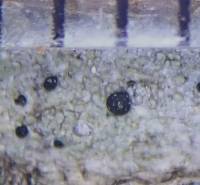
Consortium of Lichen Herbaria
- building a Global Consortium of Bryophytes and Lichens as keystones of cryptobiotic communities -
- Home
- Search
- Images
- Species Checklists
- US States: O-Z >
- US National Parks
- Central America
- South America
- US National Parks
- Southern Subpolar Region
|
|
|
|
Family: Lecideaceae
[Lecidea turgidula var. pulveracea Th. Fr.] |
Nash, T.H., Ryan, B.D., Gries, C., Bungartz, F., (eds.) 2004. Lichen Flora of the Greater Sonoran Desert Region. Vol 2. Thallus: thin, granular or endosubstratal episubstratal granules: if present, up to 0.1 µm in diam. surface: whitish to greenish gray or beige, dull, esorediate in Sonoran specimens (but see notes below) Apothecia: rounded to flexuose or tuberculate, sessile with a constricted base, 0.2-0.85(-1.2) mm wide disc: dark gray to black, often whitish or bluish pruinose, weakly to strongly convex margin: lacking from the beginning exciple: hyaline to brown below, turquoise or greenish brown (cinereorufagreen) near hymenium, N+ violet, laterally 25-50 µm wide, basally 30-60 µm wide, composed of branched and anastomosing, radiating hyphae with 0.7-1 wide, apically unthickened lumina epihymenium: greenish ochre to deep turquoise (cinereorufa-green), composed of amorphous green pigment and ochre granules, 5-10 µm thick or streaking into the hymenium, N+ violet hymenium: hyaline to pale green, 25-40 µm tall; paraphyses: hyaline, with 0.7-1 µm wide, apically unthickened lumina, moderately branched and anastomosing subhymenium: pale yellow to brown, poorly distinguishable from the hypothecium, c. 50 µm thick hypothecium: pale yellow to sordid reddish brown, 50-125 µm thick asci: clavate, Bacidia-type with an I+ blue tholus containing an indistinct, lighter blue, tapering axial body, 8-spored ascospores: hyaline, simple, narrowly ellipsoid, sometimes slightly curved, (6.5-)8.2-9.8(-11.5) x (2.5-)2.7-3.4(-4) µm Pycnidia: not seen Spot tests: thallus K-, C-, KC-, P-, UV- Secondary metabolites: pseudoplacodiolic acid. Substrate and ecology: on conifer twigs and wood, 1950-2500 m World distribution: North America and Europe Sonoran distribution: montane areas of Arizona. Notes: In typically developed L. leprarioides, the thallus is either endosubstratal or sorediate. Some of the Sonoran collections have an episubstratal thallus that is granular, but not sorediate, and could hence belong to L. turgidula. We, nevertheless, follow the concept of Tønsberg (1992), who distinguishes L. leprarioides with pseudoplacodiolic acid from L. turgidula with placodiolic acid. Lecidea trapelioides is anatomically similar but can be distinguished on account of its areolate thallus, slightly narrower spores and having gyrophoric and usnic acids. |
|
|
|
Powered by Symbiota























